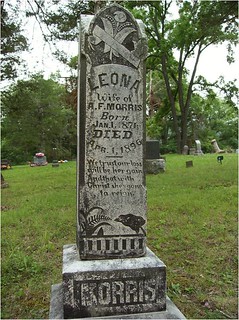Some of the soft limestone, hand-carved tombstones in the county are eroding at a rapid pace, mainly due to the freeze/thaw cycles in the area. In addition, many of the older markers are covered with various lichens and dirt, causing the stones to be illegible without some extra care. Our Hoppers were appalled to learn, upon revisiting a cemetery for a photo hop, that we could no longer read several tombstones at a cemetery just two years after transcribing the markers.

It’s always a source of controversy among the “experts” throughout the country on whether or not to clean and chalk, and what supplies are the safest to use, both to the markers and the environment. We have conducted several tests, and much research, on all options and now follow certain policies in Taney County, and surrounding border areas.
Policies & Procedures
During his extensive research for safe handling practices for the Hoppers, retired mineralogist member Karl not only visited with the local funeral homes and monument companies in the area, but also contacted the Crayola brand company to discuss the safety of their sidewalk chalk. Based on his findings, the Hoppers now chalk markers if needed for legibility or photography, following strict policies outlined below. This enables researchers to not only read the full inscription, but also learn more about the deceased through the use of symbolism, such as faith and organizational affiliations. It also allows the Hoppers to have a photo of as many stones as possible before they become illegible. As Find A Grave no longer allows photos of chalked tombstones on its site, click here to view our photos.
-
Policy 1
- Only Crayola brand sidewalk chalk is to be used, as it has passed stringent safety tests for children, as well as damage to clothing, sidewalks, and other surfaces. Foreign imported brands may contain lead or other unknown additives, or may stain and damage the stones.
-
Policy 2
- When possible, the most pastel-colored chalk is to be used so it is less intrusive. (Note: that blue chalk was used by the group before this policy was set, so many older photographs will not be reflect the softer colors)
-
Policy 3
- When possible, particularly during drought conditions, chalk is to be washed off after photographs are complete.
-
Policy 4
- Neither the White River Valley Historical Society board and staff, nor its Hoppers committee, condones the use of chalk outside of Taney County, or border area cemeteries, by anyone. This method is approved for Hoppers only in this area, provided the above policies are followed.



